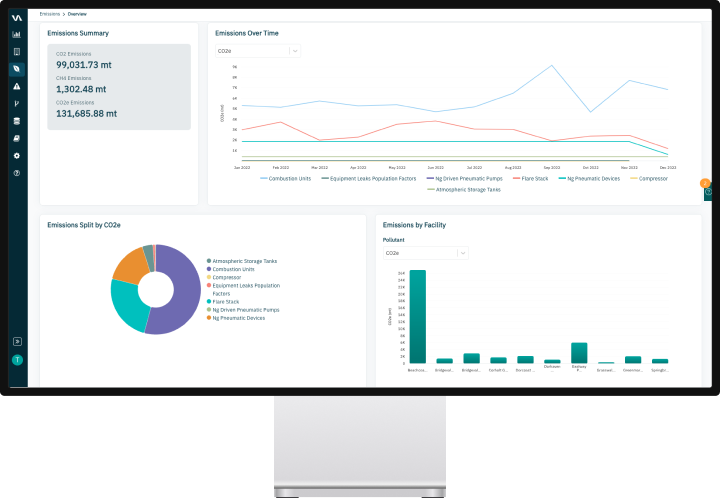
VALIDERE CONSULTING SERVICES
Measure, understand, and act with a team of experts to support you.
Collaborate with our experts in measurement science, operational data, emissions reduction, and regulations to support your key initiatives.
Get expert advice.jpg?width=590&height=702&name=Validere_prod_01%20(1).jpg)
Measure.
Work with our team of experts to create an effective emissions measurement strategy tailored to your environmental goals, including emissions monitoring technology advisory, field data acquisition planning, measurement protocol development, and inventory categorization.

Understand.
Our team can help you determine the true quantity of your emissions, interpret measured data, understand uncertainty, and correlate emissions, inventory, and operations data. Understanding your true emissions and their sources is the foundation to defining emissions reductions initiatives and developing workflows such as emissions alerting to inform field level actions.

Act.
Work with our experts to streamline regulatory and voluntary reporting submissions with data preparation, report generation, and expert advice. We can also help you navigate the landscape of voluntary emissions performance initiatives (e.g. MiQ, OGMP 2.0), as well as provide expert advice on abatement projects, forecasting and scenario analysis, and associated organizational impacts.
.jpg?width=590&height=702&name=Validere_prod_01%20(1).jpg)


How our experts can help.
Work with us and leverage our experts to achieve your environmental and operational goals.
Emissions measurement strategy
Emissions reconciliation
Measurement quantification & interpretation
Regulatory reporting & voluntary initiatives
Operational workflows & alerts
Reduction pathways
VALIDERE MANAGED SERVICES
Our senior advisors and consultants can help support key business initiatives.
Case Study
TIER optimization engagement leads to large carbon tax reductions for a Canadian gas producer.
Client pain
The client recently acquired new conventional oil and gas facilities which would be added to their existing Alberta TIER aggregate facility in order to shelter fuel use from the federal fuel charge. The client was worried about how these additions may impact their aggregate facility's compliance obligations in future years.
Our approach
Leveraging publicly available data at the well level and a thorough understanding of the regulator re-benchmarking methodology, Validere forecasted expected compliance obligations for the new aggregate facility population and modeled outcomes of different compliance approach scenarios. The analysis identified the change in aggregate population would trigger the re-benchmarking process, and ultimately result in a significant increase in compliance obligations moving forward.
Deliverables & impact
Validere provided an analysis to support an application to the regulator to re-assess the aggregate facility benchmark and establish new benchmark years. This revised compliance strategy is expected to help the client avoid an estimated $500,000 increase in compliance obligations, year over year.
Case Study
Minimized carbon taxes on client’s TIER reporting strategy by reviewing impact of changing conditions.
Client pain
The client had installed gas turbines at a conventional oil and gas facility in order to generate electricity using stranded associated gas as an alternative to flaring. The electricity was to be sold to a partner bitcoin operation. With this plan in mind, the facility has been pulled out of an existing aggregate facility and opted in as a large emitter. It was expected this strategy would result in the best compliance obligation outcome as a result of reduced overall emission intensity. Due to the cryptocurrency market downturn and operational challenges, the turbines were shut down shortly after. At the same time, the TIER Regulations were updated to include flaring within regulated emissions for aggregate facilities. The client reached out to Validere for support understanding how operational and regulatory change may impact their compliance strategy and resulting obligations.
Our approach
We utilized a thorough understanding of the regulations and quantification methodologies to model various potential compliance approach scenarios and forecast resulting compliance obligations to help the client identify the best path forward.
Deliverables & impact
We presented our analysis and proposed an approach that was expected to help the client avoid an estimated $2,000,000 in compliance obligations over the next 10 years. We completed all required TIER applications and forms to alleviate any administrative burden.
Case Study
Building confidence in existing regulatory reporting practices.
Client pain
The VP of Sustainability had questions around internal emissions quantification practices that their team had trouble answering. Specifically, there seemed to be gaps in understanding pertaining to vent sources and data used since several key team members recently left the company. At the same time, the Internal Audit division was tasked with investigating the rigor and accuracy around emission estimates that formed the basis of yearly compliance obligations. The two groups decided an internal review of processes and data was warranted.
Our approach
Validere reviewed all relevant source data (emission source inventories, operating conditions, fuel and flare gas meter readings, and gas compositions) along with the associated processes and controls involved in the internal gathering process for anomalies, gaps and areas of concern which might pose risks to accuracy and completeness in a material manner. Further, Validere compared emission estimation methodologies against those prescribed by regulatory reporting requirements to ensure adequate alignment. Finally, Validere simultaneously performed an independent quantification of emissions utilizing our Carbon Hub SaaS platform for comparison and materiality assessment.
Deliverables & impact
Validere presented our findings which included deviances from required methodologies and resulting variances in estimated emissions that were deemed immaterial, increasing confidence in previously reported values and compliance obligations paid to date. Validere's report identified existing gaps, potential risks, and areas for improvement within the existing data collection and quantification process, which will inform future plans and associated business cases to expand the existing emissions management program.
Case Study
Certification & voluntary framework gap analysis for a global energy company’s North American business unit.
Client pain
Client was pursuing MiQ certification for one of their North American business units and wanted to understand the grades they could achieve and what operational improvements would be required. At the same time, the business unit had to show progress in methane management and reductions as part of the company-wide OGMP 2.0 Gold Standard commitment. Understanding data and operational gaps to satisfy various frameworks effectively was a priority for the client.
Our approach
Validere’s services team, with guidance from our emissions experts, benchmarked the client’s data and operational procedures against the MiQ standard and OGMP 2.0 Gold Standard reporting requirements. The team put together a gap analysis with actionable recommendations (e.g. expanding annual source-level inspections at sites, enhanced record storage of leak data for reconciliation). Throughout the engagement, the Validere team collaborated closely with several champions across the client organization to gather data, verify information, and keep the team up to date on progress.
Deliverables & impact
In addition to organizing the client’s data in Validere’s Carbon Hub to streamline reporting and analysis, Validere presented the client with a gap analysis report, which covered data and operational gaps to achieving different MiQ grades and the required OGMP 2.0 L4 reporting. This work allowed the client to understand the impact of operational initiatives and make the right trade offs. Thanks to the client’s data being in Carbon Hub, the client will also save significant time on future regulatory and voluntary reporting.
Case Study
Targeted insights via reconciliation of bottom-up & direct measurement data.
Client pain
The client had invested in continuous CH4 measurement technology at a few sites with the goal to define an efficient emission mitigation strategy that is scalable across assets. However, the client struggled to translate disconnected direct measurement information into tangible operational initiatives that could mitigate emissions in a cost-effective way. Despite investments in technology and flyovers, the client still had doubts around the sources of their emissions, duration and frequency of abnormal events and impact on site-level emissions. Validere was engaged to help the client re-baseline their emissions profile and come up with meaningful mitigation insights.
Our approach
We started by understanding the facility layout and operational workflows in great detail. We consequently focused on identifying “abnormal” events (events not captured in bottom up emissions calculations as per EPA Subpart W or NGSI frameworks), attributing those equipment-level sources and quantifying them. Quantifying emissions events meant modeling out event duration and emissions rate. The Validere team leveraged the clients continuous monitor, flyover, OGI camera and operational data to recalculate the site-level emissions by equipment type. We only made assumptions when necessary to minimize quantification uncertainty.
Deliverables & impact
The analysis revealed major discrepancies between the client’s paper emissions and actual emissions. Knowing the source of the client’s actual emissions provided the basis for implementing a simple emissions abatement initiative related to better operating practices for existing equipment. Leveraging the emissions and operational workflows correlations that Validere identified as part of the work, the client is currently redefining their operational alerts to address emissions events more proactively. The client is keen to leverage the insights of this work across their assets — without needing to invest in as much measurement technology as on the test site.
Case Study
Emissions measurement strategy for a U.S. producer with ambitious emissions goals.
Client pain
Client had a goal to be a leader in their peer group for measuring and reporting transparent methane data. They invested in multiple hardware devices, including participating in a study that compared multiple vendors against measured releases. The client ultimately needed help with reconciling their measurement data to understand and eventually build out the right measurement program that could scale efficiently across their large asset base.
Our approach
We used a combination of technology and expert advisory to analyze the available measurement data and correlate against multiple factors, including operational activities. Technical teams built an analytical model that provided insights into the accuracy of measurement that was provided to the client for final assessment. Additionally, their current measurement program was reviewed and a go forward strategy was recommended. The final reconciled methane value was provided by facility for use in voluntary market transactions.
Deliverables & impact
In less than four months, we optimized their emissions measurement program, reducing projected costs by 25%, enabling the program to scale efficiently without sacrificing accuracy. The resulting data gave them confidence in their reported numbers and enabled their participation in voluntary markets.
CONSULTING & ADVISORY SERVICES
Expert advice & support.
